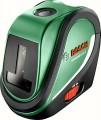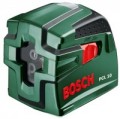Operating temperature
The temperature range at which the device is guaranteed to work for a sufficiently long time without failures, breakdowns and exceeding the measurement error specified in the characteristics. Note that we are talking primarily about the temperature of the device case, and it depends not only on the ambient temperature — for example, a tool left in the sun can overheat even in fairly cool weather.
In general, you should pay attention to this parameter when you are looking for a model for working outdoors, in unheated rooms and other places with conditions that are significantly different from indoor ones; in the first case, it makes sense to also make sure that there is dust and water protection (see "Protection class"). On the other hand, even relatively simple and "myopic" levels / rangefinders usually tolerate both heat and cold quite well.
Diode emission
The wavelength of the radiation emitted by the LED of the level or rangefinder; this parameter determines primarily the colour of the laser beam. The most widespread in modern models are LEDs with a wavelength of about 635 nm — at a relatively low cost, they provide bright red radiation, giving a well-visible projection. There are also green lasers, usually at 532 nm — the marks from them are even better visible, but such LEDs are quite expensive and rarely used. And radiation with a wave longer than 780 nm belongs to the infrared spectrum. Such a laser is invisible to the naked eye and is poorly suited for leveling, but it can be used in rangefinders — of course, with a viewfinder (see "Type" for more details).
Beam angle (vertical)
The sweep angle in the vertical plane provided by the level emitter. If there are several such radiators (for example, on both sides of the case), this parameter is given for each of them separately.
The sweep angle is, in fact, the coverage angle, that is, the width of the sector captured by the emitter when the line is formed. The wider this angle, the more convenient the device is to use, the lower the likelihood that the device will have to be moved up and down to build a line. On the other hand, a larger sweep angle (at the same range) requires more power — and this, accordingly, affects the cost and power consumption.
Beam angle (horizontal)
The sweep angle in the horizontal plane provided by the level emitter. If there are several emitters, their total coverage angle is indicated here; a typical example of such devices are models for full 360 °, not related to rotation.
Actually, all rotary devices, by definition, provide a coverage of 360 °. Therefore, it is worth paying attention to this parameter in cases where we are talking about more traditional laser levels. And here it is worth considering that a larger coverage angle, on the one hand, can provide additional convenience, on the other hand, it increases the price and power consumption of the device. So when choosing, you should proceed from real needs; detailed recommendations on this subject can be found in special sources.
Point projections
The number of individual points projected by the laser tool — rangefinder or level, see "Type" — when working. In the first case, one
point projection is standardly provided — more is simply not required to measure distances. In levels, there can be several points, and some models do not have planar projections at all and work only with points. This format may not be as convenient as displaying lines; at the same time, with the same laser power, dot marks shine brighter and are more visible, especially at long distances. In addition, there are certain types of work for which point projection is considered optimal — for example, laying sewers, determining the locations for two holes in opposite walls, etc.
Zenith
Zenith in this case is called a point projection directed vertically upwards.
By itself, such a projection can be useful, for example, if you need to make holes in several floors, located strictly one above the other. It is enough to point the "anti-aircraft" laser at the hole located directly above it — and the mark from the beam that passed through this hole will indicate the point for the hole on the next floor. And if the device also has the nadir function (see below), then the combination of these functions will be very convenient for marking the floor and ceiling at the same time — for racks, partitions, etc.: marks from the zenith and nadir are located strictly one above the other.
Nadir
Nadir in this case is called a point projection directed vertically down.
By itself, such a projection can be used, in particular, for making holes on the same vertical in ceilings located at different levels. It is enough to make one of the holes, install a level above it — and the laser beam going vertically downwards will indicate the location of the next hole. And in devices that also have the zenith function (see above), the marks from the zenith and nadir projections are located strictly one above the other. This is very convenient when marking the floor and ceiling at the same time for racks, partitions, etc.
Power source
The type and number of batteries used in the level/distance meter. All elements of standard sizes (
AA,
AAA,
C,
D,
PP3) are available in two formats — disposable batteries and rechargeable batteries. This gives the user a choice: either buy relatively inexpensive batteries every time, or invest once in a rechargeable battery with a charger, and then simply charge the battery as needed.
Branded batteries are, by definition, made only rechargeable, as are
18650 batteries.
Specific types of power today can be as follows:
— AA. A standard battery, known as a "finger battery". The power of these batteries is average, they can be used both in simple and quite advanced devices. This power supply is convenient due to the fact that AA batteries are very widespread and sold almost everywhere — due to this, finding and replacing them is usually not a problem.
— AAA. A smaller version of the AA element described above — almost identical in shape, but thinner and shorter. Such elements, known as "mini-finger" or "little fingers", have a rather low capacity and power, but are useful for portable devices, where compactness is crucial. They are also quite widespread.
— C. A cylindrical element, in the form of a rather thick "bar
...rel" — with a length of 50 mm, the diameter is 26 mm. Due to its higher capacity and power than AA, it is better suited for advanced models with "long-range" lasers, but is less commonly used and generally less common.
— D. The largest and most capacious type of standard batteries found in modern levels and distance meter: thickness and diameter are 62 and 34 mm, respectively. The main area of application for D batteries is powerful professional devices.
— Rechargeable battery. In this case, the tool is powered by an branded battery that does not belong to any standard size. This option is good because such batteries are initially created for a specific model of the level/distance meter and are supplied in the set (and in some models they are made non-removable); in addition, their specifications can significantly exceed those of standard elements of a similar size and weight. On the other hand, such power source is less convenient when the charge runs out at the wrong moment: the only way to remedy the situation is usually to recharge, and it takes quite a long time (whereas standard batteries can be replaced in just a minute).
– 18650. The name of these batteries comes from their dimensions: 18.6x65.2 mm, cylindrical, outwardly they resemble somewhat enlarged AA batteries, but they have an operating voltage of about 3.7 V and a higher capacity. In addition, all 18650 type batteries are by definition not disposable, but rechargeable batteries (lithium-ion type).
— PP3. 9-volt batteries of a spesific rectangular shape, with a pair of contacts on one of the ends. Due to the high operating voltage, they provide high power and actual capacity, so one such battery is usually enough for operation.
— LR44. Miniature batteries of "coin" type, 11.6 mm in diameter and 5.4 mm thick. Usually installed in sets of 3 and are used in compact low-power laser levels, for which small size is more important than power and capacity. Note that specifically the LR44 marking refers to relatively inexpensive alkaline batteries; more expensive and advanced silver-zinc power supplies are referred to as SR44, or 357.
— 23A12V. A rather rare option: cylindrical batteries (length 29 mm, diameter 10 mm) with a nominal voltage of 12 V.Operating time
Operating time of the device on one battery charge.
It is worth considering that these figures are quite approximate, since the operating time is measured under certain standard conditions (usually continuous operation at nominal power). And since in practice conditions may differ markedly, the operating time may turn out to be noticeably shorter or longer than stated. In addition, if the device uses replaceable batteries (AAA, AA and the like), then autonomy will also depend on the quality of the specific batteries/accumulators. Nevertheless, based on the data specified in the characteristics, it is quite possible to evaluate the capabilities of specific models and compare them with each other: the difference in the declared operating time, as a rule, proportionally corresponds to the difference in practical autonomy under the same conditions.
We also note that the operating time is specified mainly for levels; in rangefinders another parameter is more often used - the number of measurements (see below).

